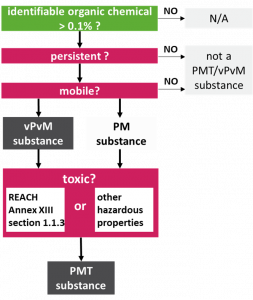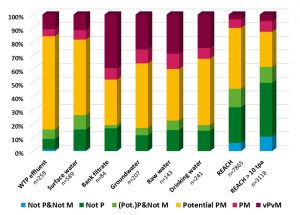Around 50 participants tuned in on November 25th, 2021 to watch the PERFORCE3 webinar “Protecting water from persistent, mobile and toxic (PMT) substances” featuring Hans Peter Arp (NGI), Sarah Hale (NGI), and Michael Neumann (UBA). A recording of the event can be found below.
Abstract
In order for a chemical substance emitted into the environment to pose a threat to drinking water resources, it must be transported from the point of emission through natural barriers such as soils, riverbanks and aquifers, and in some cases through artificial barriers. The time scales for this can vary from days to years. Substances that are persistent in the environment and mobile in the aquatic environment, as well as being toxic (PMT) or substances that are very persistent in the environment and very mobile in the aquatic environment (vPvM) have specific combinations of intrinsic substance properties that cause them to pose an inherent hazard to drinking water resources if emitted in substantial quantities.
PMT/vPvM substances are currently under the regulatory and scientific spot light. The Chemicals Strategy for Sustainability Towards a Toxic Free Environment released in 2020 presents ambitions action points for PMT/vPvM substances. They are to be included in the classification, labelling and packaging directive by the end of 2021 as well as being included as categories of substances of very high concern (SVHC) under the European chemicals regulation REACH.
PMT/vPvM substances pose an equivalent level of concern (ELoC) to persistent, bioaccumualtive and toxic (PBT) and/or very persistent and very bioacccumulative (vPvB) substances. In 2019, two PMT/vPvM substances: perfluorobutane sulfonic acid (PFBS) and 2,3,3,3-tetrafluoro-2-(heptafluoropropoxy)-propanoic acid (HFPO-DA) were identified as SVHC owing to their ELoC to PBT/vPvB substance. More recently, 1,4-dioxane has been identified as a SVHC on the same grounds, representing the first non PFAS substance identification.
As regulatory focus increases on PMT/vPvM substances, there is an increasing effort amongst researchers to identify them in the water resources, such as bank filtrate, groundwater, raw water and drinking water, and to develop analytical methods for this purpose. Further, there are also efforts to better identify PMT/vPvM substances based on environmental chemical properties used to classify them, including simulated biodegradation half-lives and biodegradability screening tests for “P”, and experimentally determined organic carbon-water partition coefficients for “M”.
In this webinar Hans Peter Arp will present the persistency and mobility properties of chemicals detected in diverse water sources and discuss these patterns in the context of substance emissions and the PMT/vPvM criteria. Sarah Hale will show how all PMT/vPvM substances pose an ELoC to PBT/vPvB substances. Michael Neumann will comment on current ambitions of the European Commission.
This is a public webinar, no registration necessary!
About the speakers
Dr Hans Peter Arp
Hans Peter Arp is a Senior Specialist in the Department of Environmental Chemistry at the Norwegian Geotechnical Institute (NGI), Oslo and Professor II at the Department of Chemistry at the Norwegian University of Science and Technology (NTNU), Trondheim, Norway. His research focuses on the relationship between substance properties of contaminants and their environmental fate, transport, impact and applicable regulation and remediation options.
Dr Sarah Hale
Sarah Hale is a senior researcher at the Norwegian Geotechnical Institute (NGI). Her current research focuses on the fate and transport of PFAS in the environment, remediation methods for PFAS contaminated water and the way in which PFAS can be regulated. She is currently leading ZeroPM: Zero pollution of persistent and mobile substance, a European Union H2020 funded project to prevent, prioritize and remove persistent and mobile substances from the environment.
Dr Michael Neumann
Michael Neumann is a senior scientific officer at the German Environment Agency (UBA) in the Department of Chemical Safety. He is an expert in environmental exposure, PBT assessment and environmental hazard classification. He invented and proposed the criteria for the identification of PMT/vPvM substances under the EU chemicals legislation REACH. In addition, he became a member of the Risk Assessment Committee (RAC) of the European Chemicals Agency (ECHA) in 2014. RAC deals with harmonized classifications, restrictions and authorizations.







